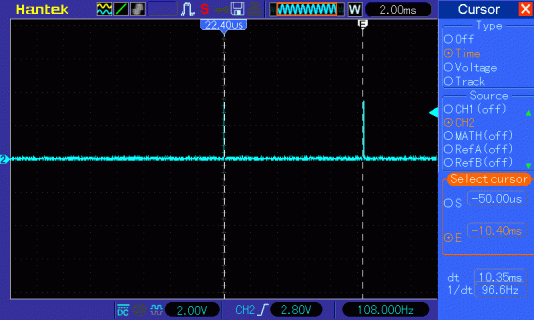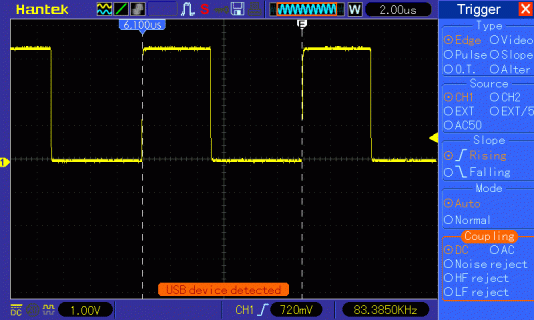//----------------------------------------------------------------------------------------------------//
//----------------------------------------Max/Pd to CTRL----------------------------------------------//
//------------------------------beta code John Harding, 2017------------------------------------------//
//----------------------------------- streamlined code: Edwin Park, 201------------------------------//
// Proposed data format concept... 17 bytes wide minimum. The USB packet size is 64 bytes. Maybe packet structure usage could be more efficient?
// Arduino cookbook states "Messages can contain one or more special characters that identify the start of the message�this is called the header."
// For an example see here: example 4.8: https://www.safaribooksonline.com/library/view/arduino-cookbook/9781449399368/ch04.html
// [header] '/' character (ascii 47) for message start identification
// [lowByte0][highByte0] //DAC channel 0
// [lowByte1][highByte1] //DAC channel 1
// [lowByte2][highByte2] //DAC channel 2
// [lowByte3][highByte3] //DAC channel 3
// [lowByte4][highByte4] //DAC channel 4
// [lowByte5][highByte5] //DAC channel 5
// [lowByte6][highByte6] //DAC channel 6
// [lowByte7][highByte7] //DAC channel 7
// [gateByte] //Gates array: 0 off, 1 on, eight gates used (one binary byte wide).
// Note: serial object in Max allows you to set @chunk [int] (data list length) //also look at DTR (data terminal ready) function. Check Pd equivalent.
//-------------------------------------HARDWARE NOTES---------------------------------------------//
/* Pin headers, looking from DAC side of main PCB
// DAC OUT HEADER (BTM):
| 6 | 4 | 2 | 0 | 1 | 3 | 5 | 7 |
// GATE HEADER (TOP):
| D+ | D- | GND | GND | GND | GND | GND | GND | GND | GND |
| D+ | D- | D04 | D02 | D03 | D05 | D06 | D08 | D12 | D09 |
*/
//-----------------------------------------------------------------------------------------------//
//------------------------------------Includes---------------------------------------------------//
#include <DA8568C.h>
//----------------------------------------------------------------------------------------------//
//-------------------------------------Constructor----------------------------------------------//
DA8568C dac; // this implies using the PINs as defined in the Library (modified to match CTRL)
// otherwise use constructor arguments like
// DA8568C(int dataoutpin=3, int spiclkpin=4, int slaveselectpin=5, int ldacpin=6, int clrpin=7);
//-----------------------------------------------------------------------------------------------//
//-------------------------------------Constants-------------------------------------------------//
#define NUM_GATES 8
#define NUM_DACS 8
const int gatePin[] = {9, 12, 8, 6, 4, 2, 3, 5};
const int togglePin = 6;
//-----------------------------------------------------------------------------------------------//
//-------------------------------------Variables-------------------------------------------------//
uint16_t dacVals[NUM_DACS];
boolean gateVals[NUM_GATES];
//-----------------------------------------------------------------------------------------------//
//-------------------------------------Main Program----------------------------------------------//
void setup() {
pinMode(togglePin, OUTPUT);
dac.init(); //initialise the DAC
initGates(); //initialise gate pins
Serial.begin(115200); // 115200 is the default
}
void loop() {
if (Serial.available()) {
char c = Serial.read();
if (c == '/') {
digitalWriteFast(togglePin, HIGH); //added for latency testing, comment out if not required
for (int i=NUM_DACS-1; i >= 0; i--) {
uint16_t dacVal = readDAC();
// Serial.print("DAC");
// Serial.print(i);
// Serial.print(": ");
// Serial.println(dacVal);
writeDAC(i, dacVal);
}
//read the gate byte at the end of the chain of bytes
uint8_t gates = readGates();
// Serial.print("gates: ");
// Serial.println(gates);
trigGates(gates);
digitalWriteFast(togglePin, LOW); //added for latency testing, comment out if not required
}
}
}
//----------------------------------------Functions--------------------------------------//
void initGates() {
for (int i = 0; i < NUM_GATES; i++) {
pinMode(gatePin[i], OUTPUT);
digitalWrite(gatePin[i], LOW);
}
}
uint8_t readGates() {
while (true) {
if (Serial.available()) {
return Serial.read();
}
}
}
void trigGates(uint8_t gates) {
for (int i = 0; i < NUM_GATES; i++) {
boolean gateVal = gates & (0x01 << i);
if (gateVal != gateVals[i]) {
digitalWriteFast(gatePin[i], gateVal);
gateVals[i] = gateVal;
}
}
}
uint16_t readDAC() {
uint8_t bytes[2];
int byte_count = 0;
while (byte_count < 2) {
if (Serial.available()) {
bytes[byte_count++] = Serial.read();
}
}
return (bytes[1] << 8) + bytes[0];
}
void writeDAC(int i, uint16_t dacVal) {
if (dacVal != dacVals[i]) {
dac.write(WRITE_UPDATE_N, i, dacVal);
dacVals[i] = dacVal;
}
}






